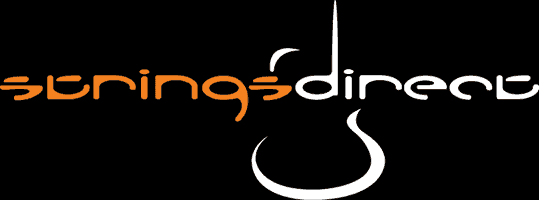Getting started with E Flat Tuning
By Strings Direct – 29 August, 2023

If you want to dial in a killer blues tune, I would recommend experimenting with E flat tuning (Eb tuning).
This is one of the simplest changes that you can make to your guitar setup. Yet it is a change that has a number of benefits. And it can make a profound difference to your tone and to the way you play your guitar.
In this article then I will be explaining a little bit more about what Eb tuning is, and how you can tune your guitar to Eb. I will also explore some of the benefits of Eb tuning, and how these can contribute to improving both the tone and playability of your guitar.
So let's get into it! Here is how to use Eb tuning, and why you should experiment with it if you are looking to improve your blues guitar tone:
What is Eb tuning?
Before we look at the benefits of tuning your guitar to Eb, I think it is important to understand exactly what it is and how it works. And the good news here is that it is pretty straightforward.
This is because Eb tuning is very closely related to standard tuning. It just involves tuning down (or flattening) the pitches of each of your strings by a single semitone.
In music, when pitches are flattened, this is denoted by the sign - b. And it is for this reason that E flat tuning is often written out as Eb tuning.
In standard tuning, the pitches of the strings on your guitar are as follows:

By comparison, in Eb tuning, the pitches of the strings on your guitar are as follows:

The only difference between the two tunings then, is that in Eb tuning, all of your strings are tuned to be one semitone lower than they are in standard tuning. You can see this again by looking at a comparison table showing the pitches across the 6 strings in each tuning:
|
|
6th String | 5th String | 4th String | 3rd String | 2nd String | 1st String |
| Standard Tuning | E | A | D | G | B | E |
| Eb Tuning | Eb | Ab | Db | Gb | Bb | Eb |
This means that if you play any note in E flat tuning on your fretboard, you will find the same note, just a single fret lower in standard tuning. For example, in Eb tuning, you will find the note of A flat (Ab) at the 5th fret on your 6th string. In standard tuning you will find this same note on the 4th fret on the same string.
There are two important points to deduce from this:
The first of these is that Eb tuning is very similar to standard tuning. There is just one semitone separating them. So when you use Eb tuning, you are not experimenting with a wildly different tuning. You are in fact just altering the pitch of your standard guitar by the smallest amount possible.
The second and more important point is that the relationship between the different strings on your guitar is exactly the same in E flat tuning as in standard tuning. This means that you can play all of the same licks, scales and chords that you use in standard tuning, when you are playing in Eb tuning. And you can do this without having to adjust your fingerings in any way.
This is significant, and also a little unusual. Normally when you use altered tunings, the relationship between the guitar strings changes. And this means that you have to learn new patterns and connections across your guitar fretboard to use them properly. That isn't the case here. And this makes Eb tuning one that is very easy and accessible to use.
Why you should use Eb tuning
Given the close relationship between standard and Eb tuning, you might be wondering why it is worth even experimenting with this new tuning. After all, how much of a difference can just one semitone make?
The answer in fact, is quite a lot. Although just one fret separates it from standard tuning, this semitone has an impact on both tone and playability. And so if you have heard about Eb tuning, but you are not yet sure why you might want to use it, then here are the 3 key benefits that might make it worth experimenting with Eb tuning. You can use it to:

1. Sound like your heroes
Over the years, a number of famous blues and rock guitarists have tuned their guitars down to Eb. Within a blues context, Stevie Ray Vaughan is arguably the guitarist best associated with this tuning. And in fact to my knowledge he almost never played in standard tuning. Instead he always opted to tune down a half-step. This was partly to accommodate his vocal range, as Vaughan found it easier to sing in a slightly lower register.
However, as I will cover in more detail below, tuning down to Eb had an impact on the setup of Vaughan's guitar, as well as his tone. Significantly, it allowed him to use heavier gauge guitar strings.
And by no means is Vaughan the only guitarist to tune down a half step. Slash always plays in Eb, and both B.B. King and Jimi Hendrix also tuned down for a number of their songs. Inspired by the tones of these early players, modern blues and blues rock guitarists like Philip Sayce and Dan Patlansky also use the same tuning.
As such, if you want to recreate the tones of these players, I would recommend tuning down to Eb. On a simplistic level, using the same tuning as these guitarists will help you to recreate their specific sound more closely.
Of course, the guitars, amps and pedals they use(d) also have a profound impact on their sound. So although altering your tuning alone won't help you to immediately sound like your heroes, it will help you get closer. And this is particularly the case if you have recreated some of the other elements of their rig.
More importantly though, is the effect that tuning down to Eb has on your guitar tone and setup more broadly. I don't think it is any coincidence that each of the guitarists listed above use(d) this tuning. They use(d) this tuning because of the impact it has on both tone and playability. Which brings me to my next point…

2. Use heavier gauge guitar strings
One of the main reasons that guitarists choose to tune down a half step, is that it allows them to use heavier gauge guitar strings. The topic of string gauge and how it relates to tone is one that remains hotly debated amongst guitar players. If you are new to the topic or want to develop a greater understanding of the differences between different gauge guitar strings, I would recommend reading the followings article which I recently wrote on the subject:
In short though, a lot of blues guitarists choose to play with heavier gauge guitar strings because they believe they produce a better tone.
As is often the case when it comes to guitar gear, I personally believe that many of the differences between heavy and light gauge guitar strings are exaggerated, especially within the context of a full rig that includes an overdriven tone and various different guitar pedals. However, having said that, there are a number of benefits to using thicker gauge guitar strings. Most notably, when compared with thinner gauge guitar strings, heavy gauge strings:
- Sustain better
- Stay in tune for longer
- Have a wider dynamic range
These are significant benefits. And this is particularly true of the final point.
If you watch a guitarist like Stevie Ray Vaughan, you will see that he often uses a very aggressive pick attack. When he does this and strikes his strings hard, he instantly adds a power and intensity to his sound, which comes from the pressure that he applies to each string.
It is not possible to adopt such an aggressive pick attack on thinner guitar strings. As a result, the variation in tone that you can achieve using nothing but your strings and pick is more limited.
These benefits do however come at a price. And that is simply that heavier gauge guitar strings are harder to play. Everything from playing faster, to applying vibrato and even fingering chords is more difficult with thick guitar strings.
This is because there is more tension running through thicker strings. So you have to use more force to fret notes and to move the strings. And depending on how long you have been playing and the strength in your fretting hand, this can make playing heavy gauge strings a real challenge. Tuning down to Eb reduces this tension. And this makes thicker gauge guitar strings easier to play, whilst allowing you to enjoy the benefits that they offer.

3. Make bending easier
Even if you are not playing with very heavy gauge guitar strings, tuning down to Eb will make string bending easier.
This is important, because string bending is without question one of the most important techniques in blues guitar playing. Yet it is also a technique with which a lot of guitarists struggle.
Typically this is because they lack the strength in their hands to bend their strings high enough. So instead of hitting the target pitch that they are aiming for, they fall just short. This turns what should be a beautiful bend into one that just misses the mark and creates dissonance as it clashes with the musical context in which they are playing.
Even if you feel comfortable hitting single tone bends though, the same might not be true of two or even two and a half tone bends. And whilst there are not a lot of guitarists who include such big bends in their playing, there are a number of them who use this technique to brilliant effect.
Within a blues context, Albert King made huge, expressive bends a characteristic element of his playing. You can hear this in many of his songs, and particularly when playing live. Just listen to his performances of songs like 'Roadhouse Blues' and 'Blues Power' to hear the wide range of his bending.
In a rock / progressive rock context, David Gilmour also crafted amazing guitar solos with big, two tone bends. The guitar solo in 'Another Brick In The Wall Pt.2' is just one obvious example which illustrates his bending style.

So if you struggle to hit bends in the way you want, or if you want to hit these big bends and don't yet have the hand strength to do so, you have two options.
The first of these is to use lighter gauge guitar strings. This will reduce the tension across your strings and make them easier to bend.
The second option is to tune down to Eb. And it is this option that was - and still is - favoured by the majority of the guitarists listed above. This is because when you tune down - rather than using lighter gauge guitar strings - you get the best of both worlds. You can benefit from the sustain and dynamic range of heavy strings, whilst still being able to execute a variety of big, two tone bends.
Closing thoughts
Well there we have it, some of the key benefits of using Eb tuning. When guitarists first learn how closely related Eb tuning is to standard tuning, they sometimes try to recreate Eb tuning by sticking in standard tuning and simply shifting everything down by a single fret.
Taking this approach however will not help you to benefit from the reduction in tension across your strings that you get when you tune down to Eb.
Not only this, but if you want to play with other musicians who have tuned down a step - or if you want to jam or play with a backing track in the same tuning - you won’t be able to use any open strings or open position chords. And this is problematic, especially if you want to play like Stevie Ray Vaughan and make use of open strings in your guitar licks and solos.
As is true of everything when it comes to crafting your guitar tone, tuning down to Eb is not a magic bullet. It is not going to instantly transform your playing. Nor will it help you to sound like Stevie Ray Vaughan or Slash overnight.
What it can do, is make a subtle difference to your tone, and a larger difference to your setup. And it is this second point which is of greater significance. For if you alter your string gauge, the way that you play your guitar will also change. And this will have a knock on effect on your vibrato, bending and pick attack.
So give it a go! It costs nothing to experiment with the tuning, and if you find that it isn't for you, then it is a change that is easy to reverse.
Once you've tried it out, you can then decide the frequency with which you want to adopt the tuning. Some guitarists have their guitars always tuned to Eb. They set it up with heavier gauge guitar strings and really get into that style.
Others keep their main guitar in standard tuning, and then set up a second guitar with heavier guitar strings and a lower tuning.
Finally, there are of course a lot of players who decide that Eb tuning doesn't work for them. And they either never use it, or just use it on occasion.
Which of these options you decide to go for will depend on your playing style and the tone you want to create. But if you have never tried to play in Eb, then my first recommendation would be to give it a try. It might totally change your playing approach and setup, and get you closer to the tone for which you are searching.

The Happy Bluesman
www.happybluesman.com
@happybluesman






